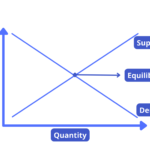Basics of Demand and Supply :
Law of Demand and Supply form the fundamental concepts of economics. Whether you are a buyer or seller, the concepts of demand & supply play an important role in your day-to-day actions. Therefore, it is important to understand these concepts before advancing to the complicated aspects of economics.
Demand:
In ordinary language, demand means a desire to have something, but in economics, demand is the desire to purchase something which is backed up by the ability and willingness to pay its price.
Therefore, Demand = Desire + Willingness to purchase + Ability to pay.
Various factors affect the demand for a product/ service, but holding all the factors constant, an increase in the price of a good or service will decrease the quantity demanded, and vice versa. (Except in certain obscure situations)
Supply:
Supply refers to the quantity of a commodity that a seller is willing and able to offer at a given price, during a certain period. Supply is a relative term, it is expressed concerning price, time & quantity.
Supply is directly proportional to price, i.e., a rise in price results in a rise in quantity supplied.
Equilibrium price:
The equilibrium price is the price at which the forces of demand and supply meet, i.e., the price at which the producer can sell all the units he wants to produce, and the buyer can buy all the units he wants.
The equilibrium price depends upon the shape and positions of the respective demand and supply curves in the market, which can be influenced by various factors.
Factors affecting Demand:
1. Price:
It is the primary factor that affects the demand for a product. Generally, demand for lower-priced items is higher.
2. Income:
The income of the consumer decides the purchasing power which intern influences the demand for the product.
3. Price of substitute goods:
The price of a substitute product in the market can affect the demand for the other product. Ex: Tea & Coffee.
4. Price of complementary goods:
A change in the price of a complementary good can affect the demand for other products.
Ex: Petrol & Cars.
5. Advertisement:
Advertisements and promotions can have an impact on the consumer’s mind thereby affecting demand.
6. Other factors:
There are several other factors like Climate, Taxation, Government policy, customs & traditions.
Factors affecting Supply:
1. Price:
The price of the commodity is one of the most important factors that affect the supply of the product in the market.
2. Cost of production:
If the cost of production increases the supply of the product might reduce & vice versa.
3. Infrastructure & Technology
Technological & infrastructural advancements such as transportation, communications, etc can lead to higher production and higher supply.
4. Government policy:
A favorable government policy may encourage the supply and vice versa. Policies related to taxation; subsidies, & industrial policies affect the supply of products.
5. Natural conditions:
This is mainly seen in the agricultural sector as the supply of agricultural goods depends upon natural conditions.
6. Other factors:
Various other factors including, the nature of the market, export & import, relative price of other goods also affect the supply of a commodity in the market.
Law of Demand & Supply:
The law of supply and demand explains the phenomenon that is familiar to us in our day-to-day lives. It explains how, everything being equal, the price of a good tends to increase when the demand increases, and the supply of that good decreases and vice versa. This fundamental concept plays a very important role in modern economics.
Importance of the Law of Demand & Supply:
The law of supply and demand is crucial because it helps investors, entrepreneurs and economists understand and predict market conditions. For example, a company launching a new product might start an advertising campaign to potentially increase the demand and thereby increase the prices of the product.
At the same time, the company might increase the prices by intentionally restricting the supply of the product in the market leading to an artificial scarcity of that product in the market.
Example of the Law of Supply and Demand:
During the initial phase of the Covid 19 pandemic, the price of masks, sanitizers & essential medicines skyrocketed due to extraordinarily high demand and limited supply in the market leading to a scarcity of these products in the market.
FAQ’s
When demand is greater than supply is known as?
When Demand Exceeds the Supply it is called “excess demand” or “Shortage”.
Where do demand and supply meet?

The demand and Supply Curve meet at the Point called “Equilibrium”.
How do Demand and Supply affect the exchange rate?
When there is more Demand and less Supply then the exchange rate is High But when Demand is less and Supply is more then the exchange rate is Low.
What are the Factors affecting Demand?

1. Price: Demand for lower-priced items is higher.
2. Income: The income of the consumer
3. Price of substitute goods: substitute products in the market can affect the demand for the other product.
4. Price of complementary goods: A change in the price of a complementary good.
5. Advertisement: Ads and promotions can have an impact on the consumer’s mind.
6. Other factors: There are several other factors like Climate, Taxation, Government policy, customs &
What are the Factors affecting Supply?

1. Price
2. Cost of production
3. Infrastructure & Technology
4. Government policy:
5. Natural conditions:
6. Other factors:
Reference: Supply and Demand: Why Markets Tick
Also Read: Role of Agriculture in the Indian Economy
